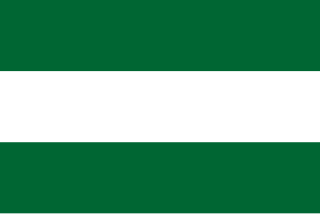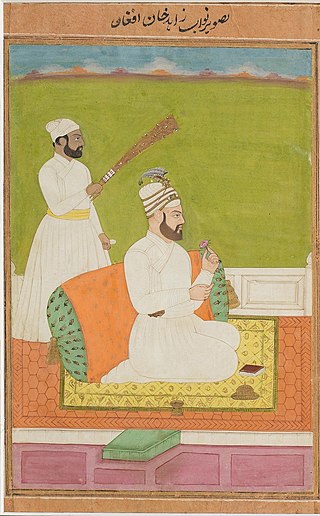
Ahmad Shāh Durrānī,also known as Ahmad Shāh Abdālī,was the first Shah and founder of the Durrani Empire,and is often regarded as the founder of modern Afghanistan.

The Durrani Empire,colloquially known as the Afghan Empire,or the Sadozai Kingdom,was an Afghan empire founded by the Durrani tribe of Pashtuns under Ahmad Shah Durrani in 1747,which spanned parts of Central Asia,the Iranian plateau,and the Indian subcontinent. At its peak,it ruled over present-day Afghanistan,much of Pakistan,parts of northeastern and southeastern Iran,eastern Turkmenistan,and northwestern India. Next to the Ottoman Empire,the Durrani Empire is considered to be among the most significant Islamic empire of the second half of the 18th century.

The Third Battle of Panipat took place on 14 January 1761 between the Maratha Confederacy and the invading army of the Durrani Empire. The battle took place in and around the city of Panipat,approximately 97 kilometres (60 mi) north of Delhi. The Afghans were supported by three key allies in India:Najib ad-Dawlah who persuaded the support of the Rohilla chiefs,elements of the declining Mughal Empire,and most prized the Oudh State under Shuja-ud-Daula. The Maratha army was led by Sadashivrao Bhau,who was third-highest authority of the Maratha Confederacy after the Chhatrapati and the Peshwa. The bulk of the Maratha army was stationed in the Deccan Plateau with the Peshwa.

Rohillas are a community of Pashtun heritage,historically found in Rohilkhand,a region in the state of Uttar Pradesh,India. It forms the largest Pashtun diaspora community in India,and has given its name to the Rohilkhand region. The Rohilla military chiefs settled in this region of northern India in the 1720s,the first of whom was Ali Mohammed Khan.

Ahmad Shah Bahadur,also known as Mirza Ahmad Shah or Mujahid-ud-Din Ahmad Shah Ghazi,was the fourteenth Mughal emperor,born to Emperor Muhammad Shah. He succeeded his father to the throne in 1748,at the age of 22. When Ahmed Shah Bahadur came to power,the Mughal Empire started to decline. Furthermore,his administrative weakness eventually led to the rise of the usurping Imad-ul-Mulk.

Alivardi Khan was the fourth Nawab of Bengal from 1740 to 1756. He toppled the Nasiri dynasty of Nawabs by defeating Sarfaraz Khan in 1740 and assumed power himself.

Shuja-ud-Din Muhammad Khan was the second Nawab of Bengal,Bihar and Orissa. He married Zainab un-nisa Begum and Azmat un-nisa Begum,the daughters of Murshid Quli Khan by Nasiri Banu Begum. Shuja-ud-Din's third wife was Durdana Begum Sahiba. After the death of his father-in-law on 30 June 1727,he ascended to the Masnad (throne) of the Nawab.
Multan in Punjab province of Pakistan is one of the oldest cities of South Asia,though its exact age has yet to be determined. Multan is known for its rich ancient heritage and historic landmarks. Multan was the primary cultural centre or capital of Punjab region mostly in late ancient and medieval era. Multan region was centre of many civilizations in its 5 millennia old history,and witnessed warfare across millennia because of its location on a major invasion route between South and Central Asia.

Shujaabad is a city and the capital of Shujabad Tehsil of Multan District in the Punjab province of Pakistan. It is located 45 km (28 mi) in south off Multan. Chenab River flows in the west of the city. Neighbouring settlements include Jalalpur Pirwala,Multan and Lodhran. The city's population is about 600,000.

Feroze Jung III or Nizam Shahabuddin Muhammad Feroz Khan Siddiqi Bayafandi also known by his sobriquet Imad-ul-Mulk,was the grand vizier of the Mughal Empire.

The Afghan–Sikh wars spanned from 1748 to 1837 in the Indian subcontinent,and saw multiple phases of fighting between the Durrani Empire and the Sikh Empire,mainly in and around Punjab region. The conflict's origins stemmed from the days of the Dal Khalsa,and continued after the Emirate of Kabul succeeded the Durrani Empire.

Timur Shah Durrani,also known as Timur Shah Abdali or Taimur Shah Abdali was the second ruler of the Afghan Durrani Empire,from November 1772 until his death in 1793. An ethnic Pashtun,he was the second eldest son of Ahmad Shah Durrani.

Ahmad Shah Durrani,the founder of the Durrani Empire,invaded Indian subcontinent a total of eight times between 1748 and 1767,following the collapse of Mughal Empire in the mid-18th century. His objectives were met through the raids and deepened the political crisis in India.
The Battle of Lahore was battle which took place between the invading Ahmed Shah Abdali and Mir Mannu,the Mughal governor of Punjab in 1752. It took place at Lahore in current day Punjab province of Pakistan. After the Mughals were defeated,Abdali decided to retain Mannu as the city's governor on his own behalf.
Shuja Khan was the Durrani governor of Multan between 1767 and 1772.

Zahid Khan was the Mughal subedar of Multan province between 1745 and 1748. He descended from an ethnic Saddozai Pashtun family long domiciled in Multan,and rose to the position of Nawab of Multan in the aftermath of the invasion of Nader Shah,owing to his personal relations with the Mughal courtier Qamar-ud-Din Khan.
Maharaja Beni Bahadur was an administrator,minister,soldier and househelp in the courts of the Nawabs of Awadh from 1733 / 1734 to at least 1798 and at most 1814. He was most notable for his rapid rise to power,industry and charity.
Diwan Singh Chachowalia was a Bhangi Sikh sardar and warlord who was the governor of Multan between 1772 and 1780 on the behalf of his half-brother Jhanda Singh.












